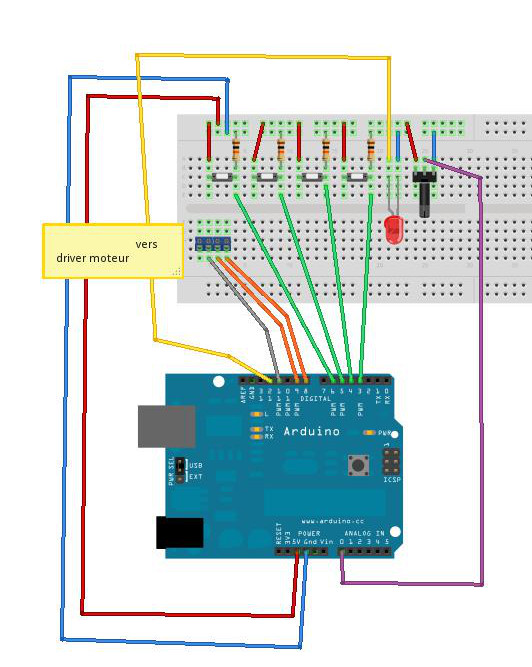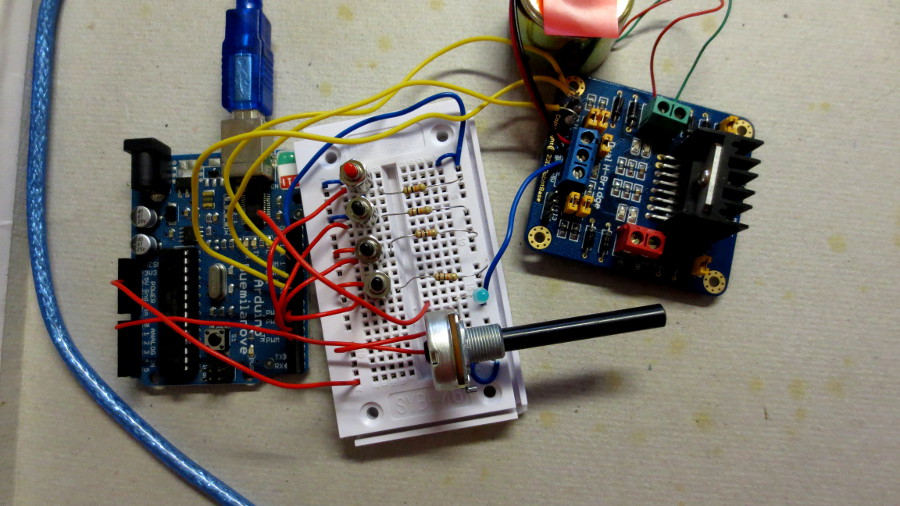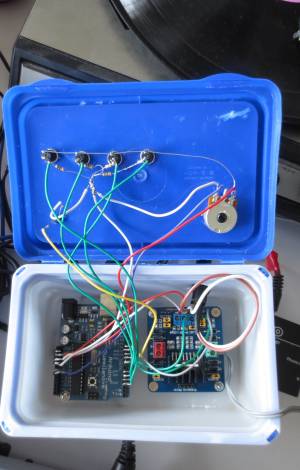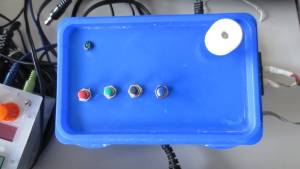Ceci est une ancienne révision du document !
Table des matières
Loop-Vinyl
Quelle platine?
Entraînement par courroie
Pour le moment c'est une platine à courroie qui permet d'entraîner le plateau. L'inertie de ce mode d'entraînement permet de faire des boucles avec une vitesse non constante au début et à la fin du cycle.
Entraînement direct
Pas encore tester mais dans le principe la vitesse devrait être constante en début et fin de boucle.
Un peu d'électronique
Matériel
- 4 switch momentanés
- 4 résitances de 10k
- 1 potentiomètre linéaire de 100k
- 1 led
- du fil
Connexion de la platine
Il suffit de souder deux fils aux bornes du moteur pour les relier au driver moteur
Schéma de cablage
Ce schéma ne fait pas apparaître l'alimentation du moteur
- Sur une platine d'essai :
- Dans une boite :
Driver moteur
Pour ce test j'ai utilisé un circuit basé sur un pont en H du type L298N, il permet de contrôler le sens de rotation ainsi que la vitesse d'un moteur CC ou d'un pas à pas.
Un peu de code
Voià le code arduino basé sur StopWatch de Paul Badger. Merci à Olivier et Ludo pour leur aide précieuse…
int pinPot = 0 ; //potentiomètre réglage vitesse
#define ledPin 12 // LED connected to digital pin 13 #define buttonPin 3 // button loop
int value = LOW; // previous value of the LED int buttonState; // variable to store button state int lastButtonState; // variable to store last button state int blinking; // condition for blinking - timer is timing long interval = 100; // blink interval - change to suit long previousMillis = 0; // variable to store last time LED was updated long startTime, startTimeLoop; // start time for stop watch long elapsedTime ; // elapsed time for stop watch int fractional; // variable used to store fractional part of time boolean avant;
void setup()
{
Serial.begin(9600);
pinMode( 3, INPUT); //loop
pinMode( 4, INPUT); //play
pinMode( 5 , INPUT); //stop
pinMode( 6 , INPUT); //reverse
pinMode( 8 , OUTPUT); //commande moteur I1 (sens rotation)
pinMode( 9 , OUTPUT); //commande moteur I2 (sens rotation)
pinMode( 11 , OUTPUT); //commande moteur vitesse (pwm)
//pinMode(buttonPin, INPUT); // not really necessary, pins default to INPUT anyway digitalWrite(3, HIGH); // turn on pullup resistors. Wire button so that press shorts pin to ground. avant = true;
}
void loop()
{
//Serial.print(".");
loopage(); //programme de comptage de temps entre 2 impulsions
play();
stopage();
reverse();
pinPot = analogRead(0) ; //lecture valeur potentiomètre Vitesse
analogWrite(11 , analogRead(0)); //valeur vitesse pwm
//Serial.print("pot");
//Serial.println(pinPot, DEC);
if (elapsedTime != 0) {
lectureLoopage();
}
}
void play()
{
if (digitalRead(6) == HIGH)
{
digitalWrite( 8 , HIGH );
digitalWrite( 9 , LOW );
elapsedTime = 0;
}
}
void stopage()
{
if (digitalRead(5) == HIGH)
{
digitalWrite( 8 , LOW );
digitalWrite( 9 , LOW );
elapsedTime = 0;
}
}
void reverse()
{
if (digitalRead(4) == HIGH)
{
digitalWrite( 8 , LOW );
digitalWrite( 9 , HIGH );
elapsedTime = 0;
}
}
void loopage()
{
// check for button press
buttonState = digitalRead(3); // read the button state and store
if (buttonState == LOW && lastButtonState == HIGH && blinking == false){ // check for a high to low transition
// if true then found a new button press while clock is not running - start the clock
startTime = millis(); // store the start time blinking = true; // turn on blinking while timing delay(5); // short delay to debounce switch lastButtonState = buttonState; // store buttonState in lastButtonState, to compare next time
}
else if (buttonState == LOW && lastButtonState == HIGH && blinking == true){ // check for a high to low transition
// if true then found a new button press while clock is running - stop the clock and report
elapsedTime = millis() - startTime; // store elapsed time blinking = false; // turn off blinking, all done timing lastButtonState = buttonState; startTimeLoop = millis(); avant = true; digitalWrite( 8 , HIGH ); digitalWrite( 9 , LOW );
// store buttonState in lastButtonState, to compare next time
// routine to report elapsed time Serial.print( (int)(elapsedTime / 1000L)); // divide by 1000 to convert to seconds - then cast to an int to print
//Serial.print("."); // print decimal point
// use modulo operator to get fractional part of time fractional = (int)(elapsedTime % 1000L);
// pad in leading zeros - wouldn't it be nice if
// Arduino language had a flag for this? :)
if (fractional == 0)
Serial.print("000"); // add three zero's
else if (fractional < 10) // if fractional < 10 the 0 is ignored giving a wrong time, so add the zeros
Serial.print("00"); // add two zeros
else if (fractional < 100)
Serial.print("0"); // add one zero
Serial.println(fractional); // print fractional part of time
}
else{
lastButtonState = buttonState; // store buttonState in lastButtonState, to compare next time
}
// blink routine - blink the LED while timing // check to see if it's time to blink the LED; that is, the difference // between the current time and last time we blinked the LED is larger than // the interval at which we want to blink the LED.
if ( (millis() - previousMillis > interval) ) {
if (blinking == true){
previousMillis = millis(); // remember the last time we blinked the LED
// if the LED is off turn it on and vice-versa.
if (value == LOW)
value = HIGH;
else
value = LOW;
digitalWrite(ledPin, value);
}
else{
digitalWrite(ledPin, LOW); // turn off LED when not blinking
}
}
}
void lectureLoopage() {
if (elapsedTime <= millis() - startTimeLoop) {
startTimeLoop = millis();
avant = !avant;
if (!avant) {
//reverse
digitalWrite( 8 , LOW );
digitalWrite( 9 , HIGH );
}
if (avant) {
//play
digitalWrite( 8 , HIGH );
digitalWrite( 9 , LOW );
}
} }





